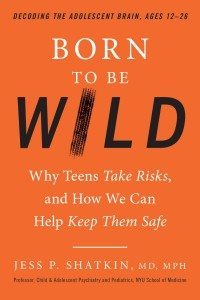 The most common way that schools partner with parents to help teens counter their natural propensity to engage in risky behavior is to warn them of the potential consequences. Most drug and alcohol education or sex education programs have the underlying assumption that teenagers underestimate the risks they face. In Born to Be Wild, Dr. Jess Shatkin argues that this approach does not align with current research and neuroscience as he cites evidence that teens actually tend to overestimate the dangers they face from risky behavior. The problems instead lie in primarily peer effects and a lack of rules of thumb for how to handle risky situations since teens do not have a bank of experiences from which to draw. As Dr. Shatkin argues, “the more we debate a decision, like an adolescent does, the more likely we are to rationalize any given risky behavior.” Though the book does not provide quick and easy solutions, the final three chapters focus on the deep and meaningful character education work that parents, schools, and the wider society can utilize to support students as they navigate adolescence.
The most common way that schools partner with parents to help teens counter their natural propensity to engage in risky behavior is to warn them of the potential consequences. Most drug and alcohol education or sex education programs have the underlying assumption that teenagers underestimate the risks they face. In Born to Be Wild, Dr. Jess Shatkin argues that this approach does not align with current research and neuroscience as he cites evidence that teens actually tend to overestimate the dangers they face from risky behavior. The problems instead lie in primarily peer effects and a lack of rules of thumb for how to handle risky situations since teens do not have a bank of experiences from which to draw. As Dr. Shatkin argues, “the more we debate a decision, like an adolescent does, the more likely we are to rationalize any given risky behavior.” Though the book does not provide quick and easy solutions, the final three chapters focus on the deep and meaningful character education work that parents, schools, and the wider society can utilize to support students as they navigate adolescence.
Born to Be Wild: Why Teens Take Risks, and How We Can Help Keep Them Safe
online pharmacy buy strattera no prescription
